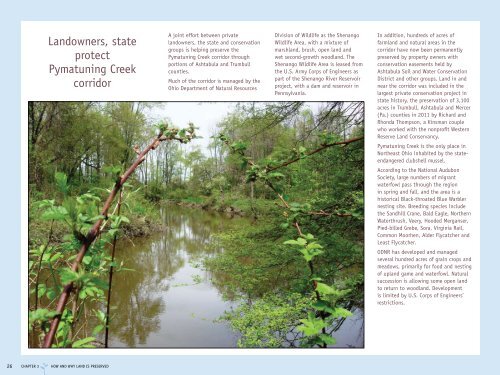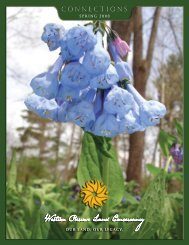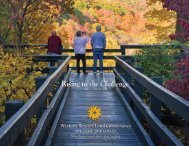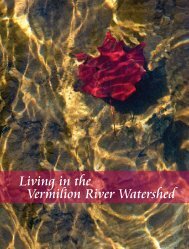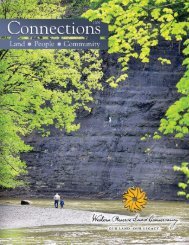Common Ground - Western Reserve Land Conservancy
Common Ground - Western Reserve Land Conservancy
Common Ground - Western Reserve Land Conservancy
You also want an ePaper? Increase the reach of your titles
YUMPU automatically turns print PDFs into web optimized ePapers that Google loves.
<strong>Land</strong>owners, state<br />
protect<br />
Pymatuning Creek<br />
corridor<br />
26 CHAPTER 3 HOW AND WHY LAND IS PRESERVED<br />
A joint effort between private<br />
landowners, the state and conservation<br />
groups is helping preserve the<br />
Pymatuning Creek corridor through<br />
portions of Ashtabula and Trumbull<br />
counties.<br />
Much of the corridor is managed by the<br />
Ohio Department of Natural Resources<br />
Division of Wildlife as the Shenango<br />
Wildlife Area, with a mixture of<br />
marshland, brush, open land and<br />
wet second-growth woodland. The<br />
Shenango Wildlife Area is leased from<br />
the U.S. Army Corps of Engineers as<br />
part of the Shenango River Reservoir<br />
project, with a dam and reservoir in<br />
Pennsylvania.<br />
In addition, hundreds of acres of<br />
farmland and natural areas in the<br />
corridor have now been permanently<br />
preserved by property owners with<br />
conservation easements held by<br />
Ashtabula Soil and Water Conservation<br />
District and other groups. <strong>Land</strong> in and<br />
near the corridor was included in the<br />
largest private conservation project in<br />
state history, the preservation of 3,100<br />
acres in Trumbull, Ashtabula and Mercer<br />
(Pa.) counties in 2011 by Richard and<br />
Rhonda Thompson, a Kinsman couple<br />
who worked with the nonprofit <strong>Western</strong><br />
<strong>Reserve</strong> <strong>Land</strong> <strong>Conservancy</strong>.<br />
Pymatuning Creek is the only place in<br />
Northeast Ohio inhabited by the stateendangered<br />
clubshell mussel.<br />
According to the National Audubon<br />
Society, large numbers of migrant<br />
waterfowl pass through the region<br />
in spring and fall, and the area is a<br />
historical Black-throated Blue Warbler<br />
nesting site. Breeding species include<br />
the Sandhill Crane, Bald Eagle, Northern<br />
Waterthrush, Veery, Hooded Merganser,<br />
Pied-billed Grebe, Sora, Virginia Rail,<br />
<strong>Common</strong> Moorhen, Alder Flycatcher and<br />
Least Flycatcher.<br />
ODNR has developed and managed<br />
several hundred acres of grain crops and<br />
meadows, primarily for food and nesting<br />
of upland game and waterfowl. Natural<br />
succession is allowing some open land<br />
to return to woodland. Development<br />
is limited by U.S. Corps of Engineers’<br />
restrictions.


